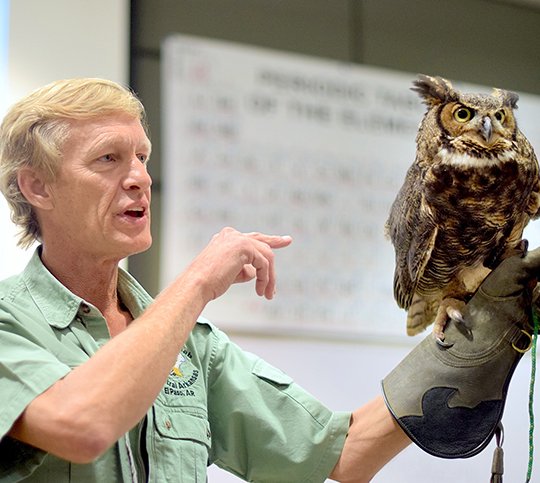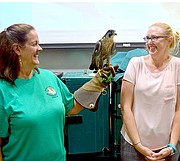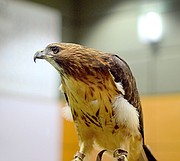Students, staff and members of the community were greeted by five birds of prey Friday on the National Park College campus during a presentation by representatives of the Raptor Rehab of Central Arkansas.
Rodney Paul founded Raptor Rehab in 2003 and serves as its director. He is licensed by the U.S. Fish and Wildlife Service to care for birds of prey.
"We get no funding from the state or from the federal government to do this," Paul said. "Everything is 100 percent out of our pocket. When I first started this, I was single, which made it a little bit easier, because it cost me about $10,000 to build my initial structures and get started.
"I actually have to pay U.S. Fish and Wildlife Service every five years. I have to pay them a fee to let me do this for free out of my pocket."
The presentation was the latest feature in the Math and Sciences Division's First Friday Lecture Series. More than 50 guests attended the presentation in the Laboratory Sciences Building.
Paul said maintaining the facility became two overwhelming for he and his wife several years ago. They started a volunteer program, which has attracted students, retirees and working professionals.
Tina Miller, a volunteer and a full-time nurse, accompanied Paul on Friday. Paul himself maintains a full-time career in the aerospace industry.
Raptor Rehab is the largest birds of prey rehabilitation center in the state. Paul and his staff care for more than 200 birds each year and maintain a 50 percent release rate.
Miller and Paul presented several birds of prey, including Gandalf, a rehabilitated vulture making his first public appearance in the center's educational programs. Also presented were Bogart, a great horned owl; Hope, a red-tailed hawk; Shaheen, a peregrine falcon; and Titus, a barn owl who was brought to the facility this year as an owlet.
Raptor Rehab later moved into an updated facility. The center focuses on birds of prey, but has also taken in ducks, geese, pelicans and other birds. Concerned citizens also go to the center with bobcats, elks, rattlesnakes and other stray animals, but they are turned over to certified professionals.
Birds of prey are tightly regulated. Raptor Rehab can rehabilitate birds of prey, but they cannot breed the animals or keep any of their remains. Guests to their presentations are not allowed to handle the animals.
Paul is one of only a few professionals in the state licensed to handle eagles. He said the center received 11 bald eagles last year with nine released and two were euthanized.
Bald eagles and peregrine falcons were among various species saved by rehabilitators from the brink of extinction after effects were seen by widespread dichlorodiphenyltrichloroethane contamination. Paul warned lead poisoning could have a similar impact on animal populations if measures are not taken.
Paul said laws are in place to prevent citizens from attempting to care for birds of prey on their own. He encouraged guests to leave chicks alone they may find in the wild.
"The bird may have a birth defect and was intentionally kicked out of the nest," Paul said. "Nature takes care of itself. We cannot save everything. It's just not possible. Nature takes care of itself."
Darlene Gentles, chairwoman of the Math and Sciences Division, said Friday's presentation was one of the most popular so far in the series, which began in the spring semester. Engineer Bob Nagy led another popular program about solar power.
"I started out with tools," Gentles said. "I wanted to have a series on tools humans have used throughout history."
Gentles said she is looking to develop a program about green energy. She said future programs could also include more animal presentations.
"Now, I just want something for the students to do that is outside of the normal classroom," Gentles said. "This is not a normal classroom. I am looking for that enrichment opportunity."
Local on 11/04/2017


